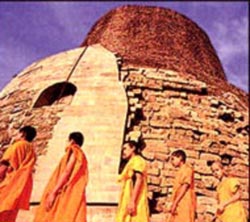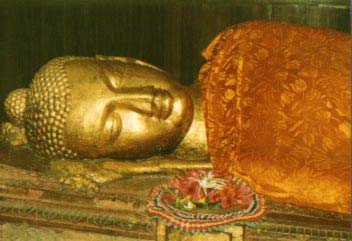| Pilgrim Places
| |||
 The Buddha or the Enlightened one was born as Prince Siddhartha before he was known as Sakyamuni and finally, as Gautama Buddha. 2500 years later, his teachings and his message of peace and goodwill continue to influence the world.
The Buddha or the Enlightened one was born as Prince Siddhartha before he was known as Sakyamuni and finally, as Gautama Buddha. 2500 years later, his teachings and his message of peace and goodwill continue to influence the world.
Upon seeing poverty, illness, old age and death, in the prime of his youth, Prince Siddhartha decided that he would not rest until he had solved the mystery of why they should be inevitable and how to overcome them. Renouncing the world, he wandered, did penance and meditated until he attained enlightenment under the Bodhi Tree. Kapilavastu (Piprahwa),110 kms from Gorakhpur in Uttar Pradesh, on the Gorakhpur Gonda loop-line with Naugarh (35 Kms.), is the nearest railway station. The capital city of the Sakya clan, and one of the earliest republics, it was in Kapilavastu's opulent environs, that the holy soul of prince Siddharth (Gautam Buddha) spent his childhood. Here he saw sorrow and pain, disease and death. Then finally when he saw a radiant happy Sadhu who had conquered all these, he decided to renounce all worldly riches and pleasures to seek truth and embark on the path of salvation. |
More about U.P. • Varanasi • Kapilvastu • Sarnath • Kushinagar • Kaushambi • Sravasti Pilgrimage • Bihar:Buddhist Sites • Haridwar-Badrinath • Legends of Kailash • Gangotri-Gaumukh • Panch Kedar < |
||
The place holds significant value for Buddhist pilgrims and has several Stupas. The archaeological excavations have revealed stone caskets containing relics believed to be that of Buddha's.
Sarnath
Gautam Buddha with his five disciples formed the first Sangha along with Yasa of Varanasi and his 54 friends. The beginning of the celebrated Mantra, `Buddham Sharanam Gachhami', owes its origin to Sarnath. The three Jewels "I go for refuge to the Buddha, I go for refuge to the Wheel of Law, I go for refuge to the Sangha" first laid down here, have remained unchanged ever since. Hence after visiting Bodhgaya, every Buddhist Pilgrim rightly endeavours to be blessed with a visit to Sarnath in his life time. Dhamekh Stupa bears particular significance at Sarnath as it signifies the"seat of the holy Buddha" as he proclaimed his faith. It is about 34 mtrs. in height and including the foundations, it can be measured upto 42 mtrs. Besides Dhamekh Stupa, Sarnath also has the ruins of Dharmajajika Stupa and that of the original Mulgandhakuti Temple which according to Hieun Tsang was about 61 mtrs. high. While in Sarnath, Buddha is said to have rested and meditated here. Emperor Ahoka (273-232 B.C.), converted to Buddhism after the Kalinga war and also visited Sarnath. A smooth glistening stone pillar, called the Ashoka Pillar commemorates his visit when he laid the foundation of the Buddhist Sangha here. The Lion Capital on top of this pillar is now the National Emblem of India. The Chaukhandi Stupa was originally a terraced temple during the Gupta period (4th to 6th Century). However in 1588 A.D., Govardhan, the son of Raja Todarmal, built an octagonal tower to commemorate the visit of Humayaun-father of Akbar. Govardhan later went on to become the Governor under Akbar's rule. Similarly Akbar, the great Mughal Emperor who revered all religions alike, raised the Chaukhandi Stupa in 1555 A.D. Kaushambi, 54 kms from Allahabad, was visited by Buddha in the 6th and 9th years after his enlightenment. He delivered several sermons here, elevating it to a centre of learning for Buddhists. Today one can see the ruins of an Ashoka Pillar, an old fort and theGhositaram Monastery. The archaeological excavations here have yielded a large number of sculptures and figurines, punch-marked and cast coins, and terracotta sculptures which show the reverence the city was held in by the devout, in times gone by. All these religious finds of historical and archaeological importance can be viewed at the Allahabad Museum.
The huge statue of the Reclining Buddha, excavated in 1876 at the temple, is one of the most momentous of all sights for the devout. It was brought from Mathura by a devout monk, Haribala, during the reign of King Kumara Gupta in the 5th Century A.D. The whole of Kushinagar, since the Mahaparinirvana of Gautam Buddha, was turned into a memorial site with stupas including the relic stupa-Mukutbadhana and the Chaitayas and Viharas, built by the devout kings of the Gupta period. The Chinese travellers Fa Hien, Hieun Tsang and T. Ising visited Kushinagar during different centuries and recorded a graphic account of the place which later fell to bad times, due to lack of patronage. These recordings provided the vital clues for excavations done centuries later by Sir Alexander Cunningham. The sites to be visited at Kushinagar fall in three categories : The Mahaparinirvana Temple, commemorating the place of the great event with a reclining statue of Lord Buddha; Mata Kunwar Shrine containing a 10th Century blue schist image of Buddha; and Rambhar Stupa, which is supposedly the spot where Lord Buddha was cremated and his relics divided into eight equal parts. Apart from this, a Chinese Temple, a Buddhist Temple, a Tibetan Temple and the Indo-Japan-Srilanka Buddhist Centre hold significant religious value for pilgrims. Situated 134 ms from Lucknow and 29 kms. from Balarampur, Sravasti, the capital of the ancient kingdom of Kosala, has the honour for sheltering Buddha for 24 rainy seasons in the Jetvana Gardens. The city, believed to be founded by the mythological king Sravast, has age-old stupas, majestic monasteries and several temples. Buddha is said to have performed some miracles here. This holy place also has the famous Anand Bodhi tree, an offspring of the one, said to have been planted by Buddha's main disciple Anand.
|
|||
Editor: Romola Butalia (c) India Travelogue. All rights reserved. |
|||

 Sarnath, about 10 kms from the holy city of Varanasi, is the blessed locale where more than 2,500 years ago Buddha chose to deliver his first sermon, after attaining Nirvana. The five disciples who had followed him were surprised to see the mesmerising, glowing countenance of Buddha, who convinced them when he delivered his first sermon before them, now termed Dharamachakara Pravartan. This set in motion the great Budhhist tradition of the Sangha, for popularising the teaching of the great ascetic, world-wide.
Sarnath, about 10 kms from the holy city of Varanasi, is the blessed locale where more than 2,500 years ago Buddha chose to deliver his first sermon, after attaining Nirvana. The five disciples who had followed him were surprised to see the mesmerising, glowing countenance of Buddha, who convinced them when he delivered his first sermon before them, now termed Dharamachakara Pravartan. This set in motion the great Budhhist tradition of the Sangha, for popularising the teaching of the great ascetic, world-wide.
 Kushinagar (Kushinara of yore) is a revered place for Buddhist pilgrims, 55 kms away from Gorakhpur. It was here that the Tathagata, the reciter of truth, breathed his last with the words, "Behold now, brethren, I exhort you, saying, decay is inherent in all component things! Work out your salvation with diligence!" A temple dedicated to the event - the Mahaparinirvana temple today stands amidst a serene `sal' grove .... as if still reminiscing the great demise.
Kushinagar (Kushinara of yore) is a revered place for Buddhist pilgrims, 55 kms away from Gorakhpur. It was here that the Tathagata, the reciter of truth, breathed his last with the words, "Behold now, brethren, I exhort you, saying, decay is inherent in all component things! Work out your salvation with diligence!" A temple dedicated to the event - the Mahaparinirvana temple today stands amidst a serene `sal' grove .... as if still reminiscing the great demise.